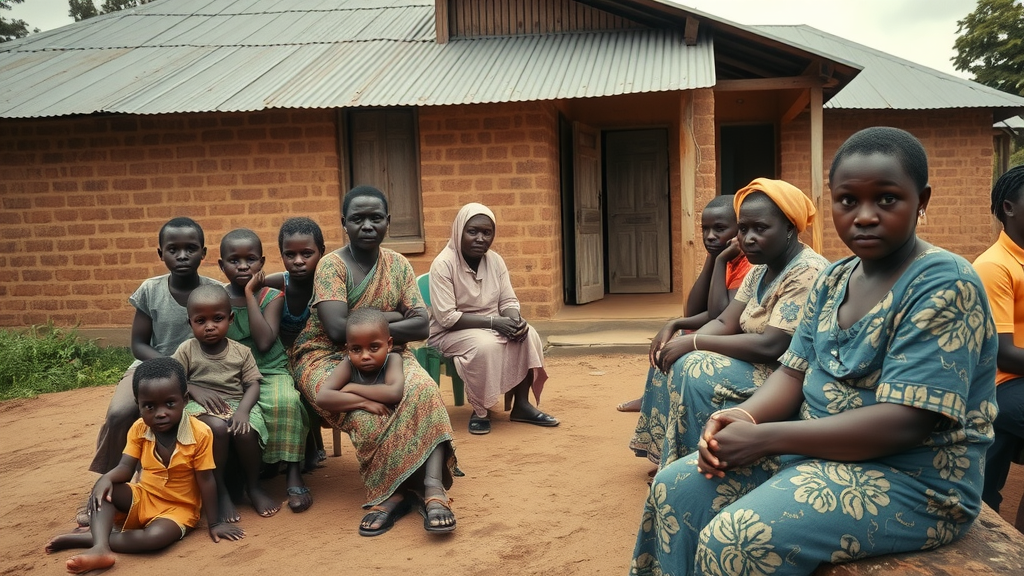Startling progress and persistent challenges: Uganda’s journey from basic remedies to a modern, multifaceted care system is filled with dramatic turns. Did you know that in the early 20th century, life expectancy hovered below 35 years? Today, it has more than doubled, a testament to the resilience, transformation, and ongoing evolution woven into the history of healthcare in Uganda . By tracing this arc, we not only uncover milestones but also untangle the social, political, and economic forces that have shaped care for millions. Read on to discover how Uganda’s health system navigated adversity, celebrated breakthroughs, and why its story matters now more than ever.
From Humble Beginnings to a Complex Care System: The Surprising Journey of Healthcare in Uganda
"Did you know that in the early 20th century, life expectancy in Uganda hovered below 35 years? Today, this statistic has more than doubled, painting a vivid portrait of the dramatic shifts in the history of healthcare in Uganda."
-
Unconventional milestones in the history of healthcare in Uganda
-
Transformations in Uganda's health system over time
-
Key figures and moments that shaped Uganda's care system
-
Challenges that have defined Ugandan healthcare
-
Critical roles of mental health in shaping the nation's health trajectory

Uganda’s health journey began with modest roots, evolving from traditional herbal remedies and community-based practices to an ever-complex structure shaped by colonial and postcolonial changes. The intertwining influences of indigenous solutions and imported Western medicine reflect the varied paths through which Ugandan health care has developed. Communities once relied on birth attendants, herbalists, and oral traditions, forming the original safety net and health service within the fabric of daily life. These practices were deeply connected to the land and communal relationships—factors still influential today.
However, the 20th century ushered in monumental shifts. The arrival of missionaries, formal health centers, and government policy reforms expanded access but also introduced disparities. New regional referral hospitals and changes in health policy responded to rapid urbanization, conflict, pandemics like HIV/AIDS, and the growing realization that public health depended not just on services, but on the underlying social determinants. Understanding this trajectory reveals how resilience, adaptation, and community-driven initiatives underpin every advance in the history of healthcare in Uganda .
Charting the History of Healthcare in Uganda: Evolution of the Health System
The Foundations: Healthcare in Pre-Colonial and Colonial Uganda

The earliest Ugandan care systems were rooted in local knowledge and integrated well with everyday life. Traditional healers played a fundamental role, using herbal concoctions and spiritual guidance to treat illnesses. With the advent of colonial rule, the nation witnessed the birth of its first institutional health facilities, marked by the establishment of health units in trading centers and missionary outposts. Colonial authorities, viewing disease control as an extension of governance, prioritized infectious disease containment—especially malaria and sleeping sickness—while often overlooking maternal health or chronic disease management.
Mission hospitals and government-built facilities began to change the landscape, introducing formal health center systems and a new cadre of health professionals influenced by European models. These early health units, including the initial regional and national referral hospitals, laid the groundwork for Uganda’s modern health system. Importantly, the period saw the exclusion of much of the local population from sophisticated care services, sowing seeds of inequality and setting challenges for future health policy and health sector reform.
The transition from traditional to structured health services during colonial times left complex legacies. While some health services, such as vaccination campaigns and epidemic control, took root, others struggled due to under-resourcing and inadequate adaptation to local contexts. These difficulties influenced the management committee models, policy frameworks, and grassroots health provision systems present in Uganda today, marking a pivotal chapter in the history of healthcare in Uganda .
Early Hospitals and the Genesis of Uganda's Care System
One can’t discuss the evolution of Uganda’s health sector without acknowledging the establishment of its earliest hospitals. Institutions such as Mengo Hospital (founded by missionaries in 1897), and later Mulago Hospital (ultimately becoming Uganda’s National Referral Hospital), represented a turning point. These early facilities were more than just treatment centers; they were seminal training grounds for Ugandan health professionals and symbols of modernization under colonial rule.
With these hospitals, Western medical techniques began to supplement, and in some cases supplant, traditional knowledge. The creation of district health centers and the emergence of unit management committees helped expand access, but also highlighted the need for equity in the care system. Public health campaigns tackled smallpox, plague, and tuberculosis—demonstrating the powerful intersection of infrastructure, education, and societal will. The legacy of these foundational hospitals still lingers, shaping the way health policies and health services are structured in contemporary Uganda.
Over time, these early institutions would grow into a network of national and regional referral hospitals, expanding their reach and deepening Ugandan engagement with health services and the broader health system. They reflect a critical axis around which the rest of the Ugandan care system continues to revolve—a testament to resilience and adaptation in the face of change.
Driving Forces: Political, Social, and Economic Influences on the History of Healthcare in Uganda
Policy Reform and its Impact on Uganda's Health System
Political events and policy shifts have continually reshaped the Ugandan health system’s destiny. Following independence, a wave of reforms sought to integrate fragmented colonial-era structures and expand basic health service delivery. The establishment of the Ministry of Health introduced a coordinated approach to health policy and planning, with a focus on primary care and disease prevention. However, turmoil, civil conflict, and periodic regime changes sometimes stalled progress or reversed hard-won gains.
The 1980s marked a renewed commitment to decentralization, placing more responsibility for unit management committee functions at the district and sub-county level. Development of health center tiers (from Health Center I up to national referral hospitals) was supposed to streamline access and ensure a continuum of care. However, proper implementation faced setbacks from funding gaps, workforce shortages, and ongoing health sector corruption. Despite these challenges, policy evolution has enabled substantial improvements—such as expanded maternal health services and immunization programs—that continue to benefit Ugandans today.
Ultimately, Uganda’s healthcare history is deeply tied to its policy environment—both successes and setbacks have had far-reaching impacts on the health system and the delivery of equitable, effective public health support across the country.
Pandemics, Conflicts, and the Resilience of Uganda's Care System

Uganda’s care system has been tested by formidable challenges, perhaps most dramatically during the HIV/AIDS crisis and periodic outbreaks of Ebola and other infectious diseases. The earlier emergence of global pandemics required not just medical response, but also a complete overhaul of public health infrastructure and community education systems. Uganda’s remarkable mobilization against HIV/AIDS, including the rollout of counseling, testing, and antiretroviral treatment, is widely celebrated—though stigma and inequalities remain persistent.
Conflict, too, has repeatedly strained the nation’s health system. Periods of unrest led to the destruction of health facilities, disrupted supply chains, and forced migrations, all of which complicated efforts to deliver health care and increased the vulnerability of at-risk populations. Yet, under these pressures, everyday health professionals have demonstrated exceptional courage and innovation—setting up makeshift clinics, engaging NGOs, and working with community leaders to provide basic care where possible.
The story of Uganda’s care system resilience is one of ongoing adaptation. Out of adversity, health sector heroes emerged and foundational lessons were learned about the importance of flexibility, collaboration, and a truly people-centered approach to public health. Even as new threats arise, this spirit remains a cornerstone of the nation’s journey in healthcare history.
|
|
Ugandan Healthcare Milestones: A Comparative Timeline of the Health System’s Evolution (Pre-colonial to Modern Day) |
|
Era |
Key Developments |
|---|---|
|
Pre-Colonial |
Traditional healers, herbal remedies, community-based maternal health, birth attendants |
|
Colonial (late 19th – mid-20th Century) |
First hospitals and health units, missionary health centers, focus on infectious disease, health system under colonial rule |
|
Post-Independence (1962-1980s) |
Creation of Ministry of Health, first health policy implementation, expansion of health facilities, emergence of national referral hospital system |
|
Modern Era (1990s-present) |
Decentralization, increased funding for public health, HIV/AIDS response, mental health reforms, inclusion of community health systems, technological advances |
Mental Health and Inclusivity: Often Overlooked Chapters in the History of Healthcare in Uganda

The Changing Role of Mental Health in Uganda's Health System
For much of its history, mental health stood on the fringes of Uganda’s health system, often misunderstood or neglected. Social stigma, limited funding, and the overwhelming focus on communicable diseases and maternal health meant that care for mental well-being was minimal. Over the last two decades, however, mental health has begun to claim its rightful space within public health priorities—both through policy reforms and the work of dedicated advocates.
The inclusion of mental health services within Uganda’s primary health care model marked a significant shift. National referral hospitals and some regional referral hospitals have incorporated mental health units, and training for health professionals now covers basic mental health diagnosis and counseling skills. Still, the sector’s growth is hampered by ongoing shortages of specialized staff, limited community-based services, and deeply rooted misconceptions among both professionals and the public.
"For decades, mental health in Uganda’s care system remained in the shadows, only to become an emergent priority in recent strategic reforms."
Recent years have seen the birth of more inclusive policies, increased partnerships with NGOs, and wider advocacy efforts to elevate the importance of mental health across the care system. Despite the progress, Uganda’s history reminds us that sustainable change will only come when mental health is valued on par with physical health, and communities are truly empowered as agents of well-being within the national health system.
Achievements and Enduring Challenges Within Uganda’s Healthcare System
Divergent Progress: Technological Advances vs. Systemic Obstacles

The modern era of Ugandan healthcare features dramatic technological improvements: innovative healthcare information systems, improved laboratory diagnostics, telemedicine solutions, and better equipped referral hospitals. But such advances are not evenly distributed—the digital divide and infrastructure gaps still separate urban from rural care, and regional referral hospitals from under-resourced clinics.
The health sector continues to battle with accessibility disparities. Many regions, especially far from the capital, struggle with resource allocation problems, shortages of trained health workers, and fragile supply chains. Education system limitations compound these gaps, affecting the quality of unit management and care service. Maternal health and HIV/AIDS remain critical public health challenges, and efforts to address them are sometimes hampered by corrupt practices or insufficient political will.
-
Accessibility disparities
-
Resource allocation issues
-
Education and health worker shortages
-
Ongoing responses to HIV/AIDS
Overcoming these systemic barriers requires investment in health system infrastructure, continuous professional development, and the strengthening of management committee structures throughout all health units. Nevertheless, Uganda’s story is one of tenacity—and every success is a stepping stone in the continuing evolution of the history of healthcare in Uganda .
What is the healthcare system in Uganda?
The Structure and Operation of Uganda's Health System

The healthcare system in Uganda is structured as a decentralized public health framework. Services are provided at multiple levels: Health Center I (community health worker outreach), Health Center II (parish-level clinics), Health Center III (sub-county), Health Center IV (county-level, includes in-patient services), and referral hospitals (regional and national). The Ministry of Health sets policy, but local governments and unit management committees handle daily operations.
The model emphasizes primary care, maternal health services, prevention, and disease control. National referral hospitals—such as Mulago—are tasked with handling complex and advanced cases. Despite policy aiming to offer free essential care at public facilities, supply shortages and indirect costs sometimes create barriers. Private and faith-based providers also play significant roles, especially where public health facilities are scarce.
These layers, combined with ongoing reforms, reflect Uganda’s ambition to create an equitable, integrated, and sustainable health system capable of withstanding future public health challenges and expanding access to care services for all.
Who founded a hospital in Uganda?
Pioneering Figures and Milestones in Ugandan Medical History

Missionaries were critical in the foundation of Uganda’s first hospitals, with Dr. Albert Cook, a British missionary physician, being especially notable for founding Mengo Hospital in 1897. This institution became the birthplace of organized health care services and the development of a professional health workforce in Uganda.
Mulago Hospital, established in 1913 as a government facility, soon became Uganda’s main national referral hospital and a training ground for countless health professionals. Pioneers like Dr. Kato Kimbugwe and others helped shape care service norms and set Uganda on the path to healthcare leadership in the region.
Each milestone—whether hospital, health center, or policy innovation—owes much to the vision and perseverance of these individuals whose legacy continues to inform Uganda’s health system, inspiring the next generation of Ugandan care system visionaries.
What are the problems with Uganda healthcare?
Persistent Barriers Facing the History of Healthcare in Uganda

Uganda’s health sector faces persistent, intertwined barriers. Many health facilities, especially in rural and hard-to-reach areas, struggle with inadequate funding, outdated equipment, and inconsistent drug supplies. Staffing shortages, limited training opportunities, and migration of health professionals further strain care service delivery.
The health system’s multi-tiered structure sometimes results in confusion or inefficient referral networks, discouraging patients from seeking early care. Administrative bottlenecks, poor data management, and insufficient unit management committee support often hinder effective service provision. Efforts to improve maternal health and other core public health services continue to battle traditional beliefs, low literacy, and cultural taboos.
Addressing these issues demands robust leadership, increased investment, and the implementation of sustainable policies centered on community needs. Uganda’s healthcare history makes clear that future progress rests on overcoming these obstacles and delivering on the promise of equitable, high-quality care for all.
Is Ugandan healthcare free?
Public Policy, Financing, and Realities on the Ground

In principle, public healthcare is provided free of charge at government health facilities in Uganda and is supported by a combination of domestic funding and international aid. Essential health services—such as immunizations, maternal health, and treatment for common infectious diseases—are meant to be available at no cost to the patient.
However, in reality, indirect expenses often present significant barriers. Hidden charges, informal payments, and the cost of purchasing medicines outside of stockouts place an undue burden on Uganda’s most vulnerable communities. Budget limitations, delayed disbursement from the central government, and incomplete health insurance coverage reduce system efficiency and further impact access.
For the goals of the national care system to be truly realized, future reforms must address these financing gaps to ensure that the principles of universal, accessible health care are translated into an everyday experience for every Ugandan.
Frequently Asked Questions About the History of Healthcare in Uganda
-
How did Uganda’s health system respond to the HIV/AIDS crisis? Uganda is often hailed for its early, community-driven response to the HIV/AIDS epidemic. Through public education, strong political commitment, increased access to testing and antiretrovirals, and the involvement of health professionals and civil society, HIV prevalence was dramatically reduced. However, ongoing stigma and care service inequities require continued attention.
-
What role do traditional healers still play in the modern care system? Traditional healers remain vital, especially in areas with limited health care facilities. While their practices have been integrated with public health initiatives in some cases, there is still work to be done to fully harmonize traditional and biomedical approaches within Uganda’s health system.
-
Are there ongoing reforms in Uganda’s mental health sector? Yes, Uganda has recently prioritized mental health in national strategy documents, expanded training for professionals, and established mental health units at referral hospitals. However, the sector faces critical gaps in funding, workforce, and widespread acceptance, requiring multi-sectoral reform and community engagement.
-
How has foreign aid influenced the health system in Uganda? International assistance has played a significant role, especially in financing disease-specific programs (like HIV/AIDS, malaria, and TB), capacity building, infrastructure, and logistics. While such aid has improved outcomes, there remain calls for increased domestic funding and sustainable, locally led solutions in the care system.
Personal Reflections on Uganda’s Healthcare Past and Future
"The evolution of the history of healthcare in Uganda is both a testament to the nation’s resilience and a clarion call for continued action, especially in mental health and care system reforms."
Uganda’s healthcare odyssey is both a cautionary tale and a beacon of hope. While strides have been made in technology, disease response, and policy, the unfinished chapters in maternal health, mental health, and service equity demand steadfast attention. Lasting progress will depend on collaboration between government, communities, and the next generation of health system leaders.
By learning from history, Uganda can shape a future where every citizen has the right and ability to access high-quality health care, regardless of background or circumstance.
What Lessons Can We Draw From the History of Healthcare in Uganda?
-
Recognizing the importance of contextual, community-based healthcare solutions.
-
The need for long-term investment in the health system infrastructure.
-
Prioritizing mental health alongside traditional health outcomes.
These lessons highlight that sustainable and inclusive health care emerges not only from state-led efforts but from a vibrant interplay between local knowledge, resilient communities, and an adaptable care system.
Key Takeaways for Uganda’s Health System: A Vision for the Next Generation
The history of healthcare in Uganda teaches that partnership, innovation, and persistent advocacy are vital. Emphasizing health system strengthening, frontline worker support, and public engagement will pave the way for future generations. Looking ahead, Uganda’s capacity to marry tradition with technology can transform public health realities across the nation.
Explore Further: Get Involved in Uganda’s Healthcare Transformation
"Every step forward in the history of healthcare in Uganda has required collective engagement. Your awareness and advocacy can shape a healthier future."
Ready to support Uganda’s journey? Consider volunteering, supporting local NGOs, or sharing this story to spark dialogue in your network.
Watch: Visual Retrospective on the History of Healthcare in Uganda
See images, archival footage, and expert interviews about Uganda’s healthcare evolution—a story of struggle, progress, and hope.
Video: In-Depth Analysis of Uganda’s Care System and Health System Evolution
Gain deeper insight into Uganda’s transformative healthcare milestones and hear from leading experts on future priorities for the Ugandan health system.
Conclusion: Choose action—invest in knowledge, promote equity, and champion mental health for a more resilient Uganda.
Uganda’s healthcare system has undergone significant transformations over the years, evolving from traditional practices to a more structured and modern framework. For a comprehensive understanding of this evolution, the article “Healthcare in Uganda” provides an in-depth overview of the country’s health system, including its structure, reforms, and performance metrics. ( en.wikipedia.org ) Additionally, the “History of Mengo Hospital” offers insights into the establishment and development of Uganda’s oldest hospital, highlighting its pivotal role in introducing modern medical practices to the nation. ( mengohospital.org ) These resources offer valuable perspectives on the milestones and challenges that have shaped Uganda’s healthcare landscape.
 Add Row
Add Row  Add
Add 




 Add Row
Add Row  Add
Add 

Write A Comment